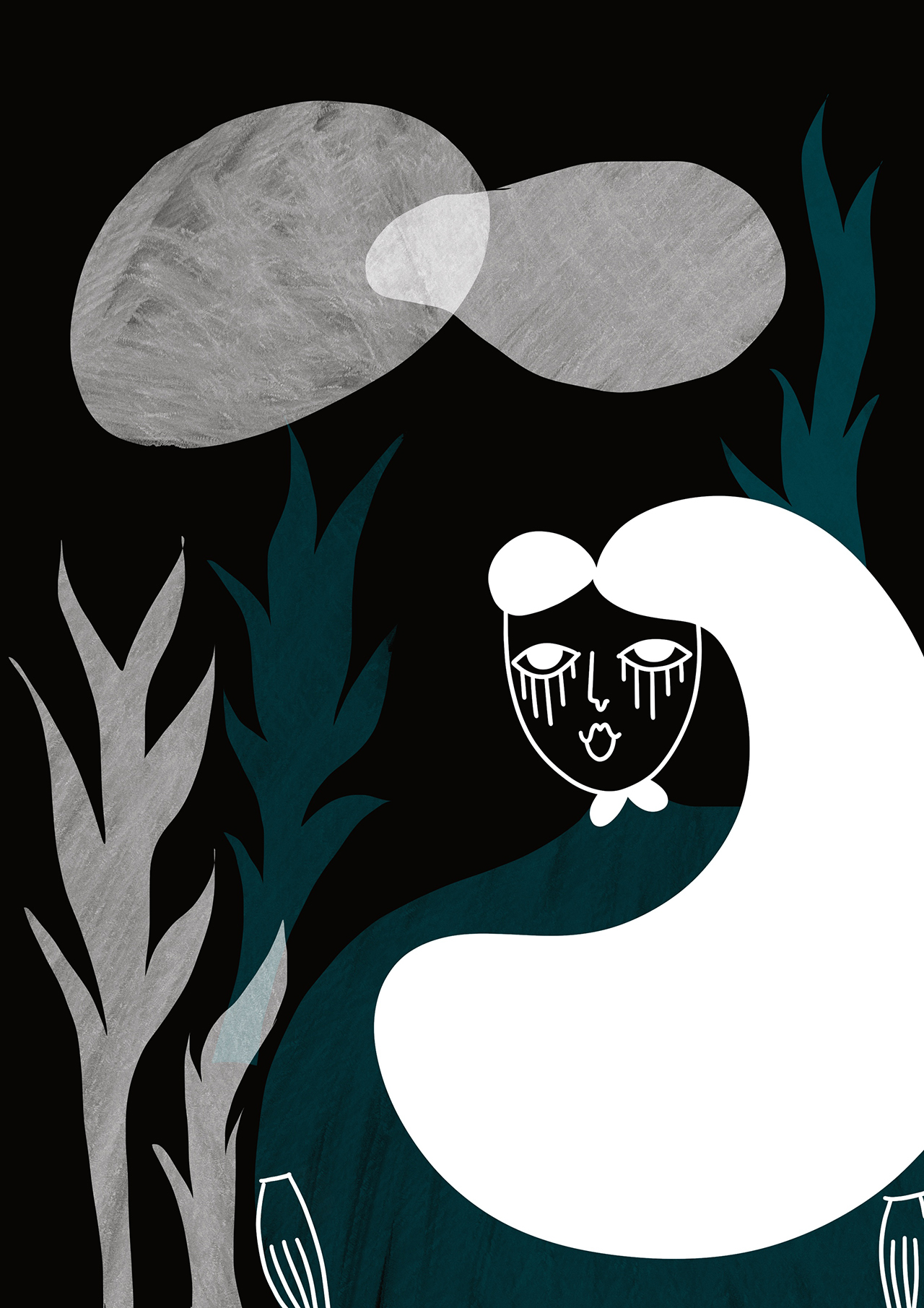#TheMysticIssue
Let's talk
THE POETESSES OF GOD
// The mulieres sanctae acted in the name of the love that they felt for Christ and, at the same time, they engaged both in the social and in politics
WORDS BY STEFANIA MASSARI
Mystical writers played a fundamental role within the so-called Querelle des femmes because, through their works and their actions, they managed to oppose a purely male-dominated society that wanted them submissive and obedient.
This condition allowed them to escape, finally released from any earthly constraint, and to describe their relationship with God through a poetic language, full of symbolisms, metaphors and allegories.
The mulieres sanctae, therefore, acted in the name of the love that they felt for Christ and, at the same time, they engaged both
in the social, showing attention to the marginalized and the poorest, and in politics, making concrete interventions in the history of Church.
The Beguines
It is especially in the period from the 12th to the 14th century that a strong presence of mystical writers is concentrated throughout Europe.
In northern Europe, for example, we speak of beguines: unmarried pious women or war widows, also coming from aristocratic
classes, who lived in enclosed places (beghinaggi-beguinages) where there was a courtyard with a church in the center. These women were not real religious, as they freely practiced chastity and poverty without making an explicit vow, and they lived a life of prayer and work, asceticism and charity, being supported by a priest who served as a spiritual guide and who lived not far from the Beguinage.
They were a sort of modern laic nuns who identified themselves in Christ and wanted to find their proper location within the Church which often opposed them so much that they were considered heretical.
Marguerite Porete, French theologian and writer, burned at the stake on 1 June 1310 bequeathed to us the mirror of simple souls. The book describes the stages of the journey in which to place the soul to reach God, described as a Father, Lover, Spouse and Son, who emanates and infuses Love. ‘The Mirror”, written in the vernacular, a language forbidden by the Church when speaking of theology (given that the official language was Latin) is a revolutionary work because it sought to restore dignity to women considered, especially in medieval times, inferior beings. Today it is possible to read it thanks to the courage of those who have copied and handed it down for centuries, challenging and opposing the religious law that required its destruction because it was considered blasphemous.
Il bizzoccaggio (The lock-up)
It is in Umbria and Tuscany that the phenomenon of “bizzoccaggio” spread more widely.
Caterina di Siena is an example. She was a visionary, a woman actively engaged both politically and socially and a prominent
writer. With the crucified Christ she made an intimate spousal fusion (mystical marriage), and her experience was told in a
correspondence of 381 letters, in an anthology entitled ‘The Orations” in which the prayers that Caterina pronounced during her ecstasies are contained and in ‘The Dialogue of Divine Providence”, her spiritual testament that is now considered one of the masterpieces of medieval mysticism literature and which constitutes the synthesis of the Saint’s thought.
Inside, in fact,
the questions she asked God during the ecstasies and the answers she received on the various questions of faith were inserted.
Despite being illiterate, Caterina managed to dictate everything she had seen and experienced to her disciples.
Simone Weil: mysticism of the 20th century
This thought of absolute devotion to Christ continued into the modern era.
Simone Weil, French writer and mystic of the 1900s, born from a wealthy Jewish family, despite having received an agnostic education, gradually approached her life, not so much to the Catholic religion disclosed by the Church of Rome, as to the
figure of Christ and his teachings. The mystic is firmly convinced that he does not want to ask for baptism and does not respect the institution of the Catholic Church which, according to her thought, “is not as Catholic as the name evokes”.
Being Catholic means being universal and it is this characteristic that the Roman Catholic Church lacks, given that it is not able to welcome all human beings of any race and creed, but makes the necessary distinctions by showing to be not very merciful. Which, on the other hand, does not make Jesus Christ who sacrificed himself on the cross for us and gave us eternal salvation. Therefore, all the men present on earth can be forgiven for their misfortunes, a term so dear to Weil, as long as their thoughts and actions are characterised by justice and love for good and truth.
In “Waiting for God”, a collection of texts on religious subjects composed between 1941 and 1942, these topics are discussed through the mystical experience of Simone Weil on how much God has enriched her life.
*
*
*
ITA
*
*
*
Le scrittrici mistiche hanno ricoperto un ruolo fondamentale all’interno della cosiddetta Querelle des femmes perché, attraverso le loro opere e le loro azioni, sono riuscite ad opporsi ad una società prettamente maschilista che le voleva sottomesse e ubbidienti.
Questa condizione ha permesso loro di evadere, sciolte finalmente da qualsiasi vincolo terreno, e di descrivere, tramite un linguaggio poetico, denso di simbolismi, metafore e allegorie, il loro rapporto con Dio.
Le mulieres sanctae, dunque, hanno agito in nome dell’amore che provavano per Cristo e, nello stesso tempo, si sono impegnate sia nel sociale, manifestando attenzione nei confronti degli emarginati e dei più poveri, sia in politica apportando concreti interventi nella storia della Chiesa.
Le Beghine
È soprattutto nel periodo che va dal XII al XIV secolo che si concentra in tutta Europa una forte presenza di scrittrici mistiche.*
Nel nord Europa, ad esempio, si parla di beghine: pie donne nubili o vedove di guerra, provenienti anche da ceti aristocratici, che vivevano in luoghi chiusi (beghinaggi) dove vi era un cortile con al centro la chiesa. Queste donne non erano vere e proprie religiose, in quanto praticavano liberamente la castità e la povertà senza farne voto esplicito, e conducevano un’esistenza fatta di preghiera e lavoro, ascesi e carità, facendosi affiancare da un sacerdote che fungeva da guida spirituale e che abitava poco distante dal beghinaggio.
Esse erano una sorta di moderne suore laiche che in Cristo si immedesimavano e che volevano trovare la loro adeguata collocazione all’interno della Chiesa che, spesso, le osteggiava tanto da ritenerle eretiche.
Marguerite Porete, teologa e scrittrice francese, bruciata sul rogo il 1° giugno 1310 ci ha lasciato in eredità “Lo specchio delle anime semplici”. Il libro descrive i gradi del cammino in cui porre l’anima per raggiungere Dio, descritto come un Padre, Amante, Sposo e Figlio, che emana e infonde Amore. “Lo Specchio”, scritto in volgare, lingua vietata dalla Chiesa per parlare di teologia (dato che la lingua ufficiale era il latino) è un’opera rivoluzionaria perché ha cercato di ridare dignità alle donne considerate, soprattutto in epoca medievale, esseri inferiori. Oggi è possibile leggerlo grazie al coraggio di coloro che lo hanno copiato e tramandato per secoli, sfidando e opponendosi alla legge religiosa che imponeva la sua distruzione perché considerato blasfemo.
Il bizzoccaggio
E’ in Umbria e in Toscana che il fenomeno del bizzocaggio si diffuse maggiormente.
Caterina da Siena ne è un esempio. Ella fu una visionaria, una donna impegnata attivamente sia a livello politico che sociale e una scrittrice di rilievo.
Con Cristo crocifisso realizzò un’intima fusione sponsale (matrimonio mistico), e la sua esperienza venne raccontata in un epistolario di 381 lettere, in un’antologia intitolata Le Orazioni nella quale furono raccolte le preghiere che Caterina pronunciava nel corso delle sue estasi e ne Il Dialogo della Divina Provvidenza, suo testamento spirituale che viene oggi considerato uno dei capolavori della letteratura mistica medievale e che costituisce la sintesi del pensiero della Santa. Al suo interno, infatti, sono state inserite le domande che ella pose a Dio Padre durante le estasi e le risposte che ricevette sulle varie questioni di fede. Nonostante fosse illetterata, Caterina riuscì a dettare tutto ciò che aveva visto e provato ai suoi discepoli.
Simone Weil: mistica del ‘900
Ma questo pensiero di devozione assoluta nei confronti di Cristo continuò fino all’epoca moderna.
Simone Weil, scrittrice e mistica francese del ‘900, nata da un’agiata famiglia di origine ebrea, pur avendo ricevuto un’educazione agnostica, nel corso della sua vita si avvicinò gradualmente, non tanto alla religione cattolica divulgata dalla Chiesa di Roma, quanto alla figura di Cristo e ai suoi insegnamenti. La mistica è fermamente convinta di non voler chiedere il battesimo e di non rispettare l’istituzione della Chiesa cattolica che, secondo il suo pensiero, “non è cattolica di fatto come lo è di nome”. Essere cattolici significa essere universali ed è questa caratteristica che manca proprio alla Chiesa cattolica romana, dato che non è in grado di accogliere tutti gli essere umani di qualsiasi razza e credo, ma fa le dovute distinzioni dimostrandosi poco misericordiosa. Cosa che, invece, non fa Gesù Cristo che si è immolato sulla croce per noi e ci ha dato la salvezza eterna. Dunque, tutti gli uomini presenti sulla terra possono essere perdonati per le loro sventure, termine tanto caro a Weil, a patto che i loro pensieri e le loro azioni siano caratterizzati dalla giustizia e dall’amore per il bene e per la verità.
Nell‘ “Attesa di Dio”, raccolta di testi di argomento religioso composti tra il 1941 e il 1942, si affrontano questi argomenti e si narra dell’esperienza mistica di Simone Weil e di quanto Dio abbia arricchito la sua vita.
*
*
*
Words by Stefania Massari.
Illustration by Martina Sobacchi
Translation by Amanda Luna Ballerini.






